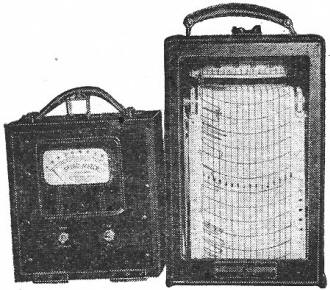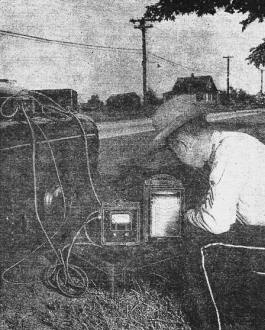Highway Radar
|
|
Radar speed guns have been the bane of drivers - and the bounty of police department coffers - since the 1940s. The technology that helped the Allied Forces win World War II was exploited immediately thereafter by law enforcement in an effort to make the highways a safer place. Rather than relying on a police officer's learned estimation of a car or truck's speed, a certified radar unit was used by a trained operator. Prior to the advent of speed radar, a common method for determining a motorist's speed was to measure the time taken to travel between two points whose distance apart was known. The information was admissible in court, but was more vulnerable to a crafty prosecutor's interrogation. Radar removed that variable, although there probably have been cases where the accuracy of the radar unit was challenged in terms of electronics performance, false signal returns, adjustment for slant ranges, etc. The cover photo of this 1947 issues of Radio-Craft magazine shows a constable atop a highway overpass with his newfangled radar unit set up. That unit operated at 2.455 MHz, smack in the middle of the current day 2.4 - 2.5 GHz ISM band. Modern police radars operate in the K band (18 to 27 GHz) and Ka band (27 to 40 GHz) in order to avoid interference with commercial devices operating at lower frequencies. Highway Radar - Connecticut system makes absolutely accurate records of automobile speeds Connecticut speedsters protesting that "they were doing only forty" will soon find themselves arguing with radar. So says Captain Ralph Buckley, traffic division head of the Connecticut State Police. Inconspicuous radar speed meters are already being operated alongside Connecticut highways in a series of tests which will probably result in the adoption of radar speed control throughout the state. The radar device is known as the Electro-Matic Speed Meter, and is a local Connecticut product, being manufactured by Eastern Industries Ltd. of Norwalk. It is a small, portable device composed of 3 units. Largest of these is the transmitter-receiver, the radar set proper. The dipole antenna is enclosed in the set, behind the bakelite front panel on which the words "Electro-Matic Speed Meter" appear. A second unit is the indicator-amplifier, and the equipment is completed by a 6- or 120-volt power supply. The instrument operates on the Doppler effect. When a series of waves is sent toward an object moving toward the transmitter, the length of the reflected waves is shorter than the wavelength as measured at the transmitter itself. This is because the moving object has moved part of a wavelength toward the transmitter in the interval between each wave. The greater the speed of the object, the greater the difference between the frequency of the transmitted and received wavelengths. (The same effect can be noted if the source of signals is itself moving toward or away from the receiver, or if the transmitter is stationary and the receiver moves. It is especially noticeable in sound, and many listeners have noticed that the pitch of a fast-approaching train's whistle is higher than the same whistle when the train is moving away from the listener.) The direct signal from the transmitter and the received signal are mixed in the receiver, and the difference frequency (which tells the speed of the moving object) is fed to the indicator-amplifier, where it is read on a meter calibrated directly in miles per hour or registered on a graphic recorder. If the car is moving at a steady speed, the indicator will swing up as it comes into the field covered by the instrument, remain there a short instant, and then drop as the car passes by. During this short period of approach at constant speed the reading is taken. By varying the angle the transmitter-receiver makes with the road this action may be adjusted to give the most positive reading. If a graphic recorder is used, a slight flattening of the top of the curve produced by each car indicates the point at which the steady speed is read. Range depends to a great extent on the height of the instrument. On the ground, it is from 75 to 100 feet. At a height of 3 feet, this range increases: to 150 feet, and at 30 feet the zone extends to 350 feet. For practical use, a range of 150 feet has given the best results, and the speed meter is mounted preferably at a height which will give approximately that range. Turning the transmitter-receiver unit slightly away from the traffic also produces more positive results by limiting the field and decreasing sensitivity for cars on the far side of the roadway. The device should be mounted as near the roadside as convenient, though errors due to angularity are less than 2% at any distance within 15 feet of the traffic path. At distances between 15 and 25 feet the error may increase to 5% on the low side. The equipment is so constructed that it can be handled by a nontechnical operator. Since it is a radio transmitter, an FCC station license is required. Any authorized employee of the state police department may then operate it without a special operator's license. The meter is constructed to work from either a 6-volt storage battery or the 120-volt 60-cycle a.c. normally used for traffic signal control power. The 3 units can be packed in a case 26 x 6 x 9 inches. The weight, including the case, is only 45 pounds. Since the range to be covered is short, output power is low - approximately 0.1 watt at 2.455 mc. The equipment is now being used to study traffic trends, road safety, and safe speeds. Later, postcards will be sent to speeders, "telling them when and where they were exceeding the speed limit" and warning that further violations will result in prosecution. Only then will the speed meter records be introduced in court and the speeder confronted with the unanswerable testimony of an electronic instrument.
Posted November 17, 2020 |
|



